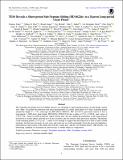TESS Reveals a Short-period Sub-Neptune Sibling (HD 86226c) to a Known Long-period Giant Planet
Author(s)
Ricker, George R; Vanderspek, Roland K; Seager, Sara; Shporer, Abraham-Avi; Wong, Ian
DownloadPublished version (7.592Mb)
Publisher Policy
Publisher Policy
Article is made available in accordance with the publisher's policy and may be subject to US copyright law. Please refer to the publisher's site for terms of use.
Terms of use
Metadata
Show full item recordAbstract
© 2020. The American Astronomical Society. All rights reserved. The Transiting Exoplanet Survey Satellite mission was designed to find transiting planets around bright, nearby stars. Here, we present the detection and mass measurement of a small, short-period (≈4 days) transiting planet around the bright (V = 7.9), solar-type star HD 86226 (TOI-652, TIC 22221375), previously known to host a long-period (∼1600 days) giant planet. HD 86226c (TOI-652.01) has a radius of 2.16 0.08 R ⊕ and a mass of M ⊕, based on archival and new radial velocity data. We also update the parameters of the longer-period, not-known-to-transit planet, and find it to be less eccentric and less massive than previously reported. The density of the transiting planet is 3.97 g cm-3, which is low enough to suggest that the planet has at least a small volatile envelope, but the mass fractions of rock, iron, and water are not well-constrained. Given the host star brightness, planet period, and location of the planet near both the "radius gap"and the "hot Neptune desert,"HD 86226c is an interesting candidate for transmission spectroscopy to further refine its composition.
Date issued
2020-08Department
MIT Kavli Institute for Astrophysics and Space Research; Massachusetts Institute of Technology. Department of Physics; Massachusetts Institute of Technology. Department of Earth, Atmospheric, and Planetary Sciences; Massachusetts Institute of Technology. Department of Aeronautics and AstronauticsJournal
Astronomical Journal
Publisher
American Astronomical Society
ISSN
1538-3881